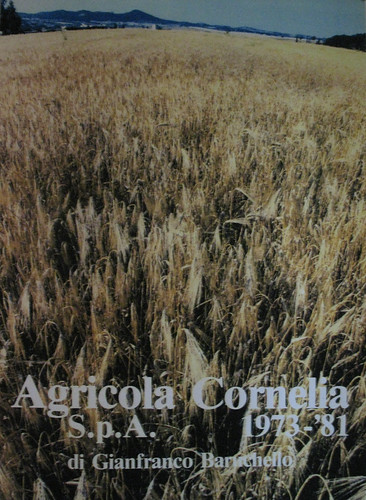[DIEGO]
There once was an Italian artist, fairly established, who made his art in an environment of social unrest, of cultural assessing and of creative goals repositioning.
It was Rome, in the ’60s, his experimental films were shown around Europe and USA, his drawings and assemblages too.
Civil unrest turned violent, so his concern shifted, his research and investigation platform changed location, literally.
Gianfranco Barucchello moved to the countriside, it was 1973, to start a new way of looking at art, while farming: Agricola Cornelia.
His influences were predominantly duchampians, indeed he was a good friend of the French artist, with whom he had ongoing exchanges, yet beyond the rhetoric of ‘ready made’ surrounding Agricola Cornelia and applied onto sugar beets, barley, sheep and milk from cows, there was also a parallel concern, an issue topical today as ever, the relationship between ‘valore di scambio and valore d’uso’, ‘commercial value vs utilitarian value.
This was one topic that constituted the basis for the economy politics and philosophy of Marx, in Das Kapital, whose writings heavily influenced the geopolitical happenings of the last century.
Well, Baruchello took the plunge and dived, as an accomplished artist, into the nitty and gritty of what that meant.
Can being a primary producer be seen and/or have any narrative value in the cacophonic arguments of ‘art as cultural review’, art of the everyday, art as social catalyst?
I was lucky enough to spend 3 months at the Fondazione Baruchello recently. The foundation, under the guidance of director Carla Subrizi, now preserve what once was the fields, pastures and gardens of Agricola Cornelia.
Baruchello spent 8 years farming as art (1973-81) and his books are now being rediscovered (like I did) as seminal philosophical treaties.
Remarkable the now 85 years old man who still has lots to say.
“an artist is a bit like a philosopher’s stunt-man, trying out new possibilities. If it doesn’t work doesn’t matter, as art can absorb failures just as much as strokes of geniusâ€
“the work of an artist is to be unpredictable. If you can see a clear path in your investigations, then it’s time for a sudden side jumpâ€.
Even my mother (an intentional farmer herself) liked Baruchello’s writings, laughing at the results of cultivating, rearing and harvesting experiments: Baruchello said in several interviews, the aim was not to be a successful farmer, but rather to search for narratives and meanings.
Nothing comes more loaded of meanings as the production of sustainment, and today’s post-industrial societies find themselves facing the disconnection, analyzing what it really means to position one’s life so removed from primary production.
One book in particular , How to Immagine, is getting passed about, hand to hand, to various people.
It was never produced in big numbers, and indeed I don’t even think it was ever published in Italy itself, but I strongly believe what Baruchello was doing in terms of Art and Environment, at a time when big earth moving machinery were employed to make big landscape statements, is of value now.
It’s a stream of thought, jumping from beehives to feminism, from squatting as political action to the value of knowing how to select a good sheep from a bad one by sticking a finger in its bum and smell it..
lol, sounds gross?
Uhmm
I recently replied to an email where, in the colloquial section, the correspondent said she’d love to come down to the garden to do something about her urge of gardening.
I replied “indeed, we should actually foster a new trend, a fashion statement that consecrates soil-under-your-fingernails as the new blackâ€
Lol, why not?
We all love plants after all. Indeed most people are just scared, feeling disconnected and/or not skilled enough.
Come down to the garden all, let’s experiment
🙂

